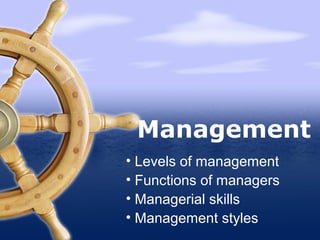
Management styles
- 1. • Levels of management • Functions of managers • Managerial skills • Management styles Management
- 2. About Management • Management involves the utilization of human and other resources (such as machinery) in a manner that best achieves the firm’s plans and objectives. • According to a recent survey by Shareholder Surveys, shareholders rank good management and long-term vision as the two most important characteristics of a firm.
- 3. Levels of Management • Top (high-level) management – managers in positions such as president, CEO, CFO and vice-president who make decisions regarding the firm’s long-run objectives. • Middle management – managers who are often responsible for the firm’s short-term decisions. • Supervisory (first-line) management – managers who are usually highly involved with the employees who engage in the day-to-day production process.
- 4. Comparison of Responsibilities Among Managers • Top Management – Set new plan to expand production & increase sales. – Communicate those plans to all managers. • Middle & Top Managers – Determine how many new employees to hire. – Determine how to charge lower prices to increase sales. – Determine how to increase advertising to increase sales. – Determine how to obtain funds to finance the expansion.
- 5. Comparison of Responsibilities Among Managers • Supervisory Managers – Provide job assignments to the new employees who are hired. – Set time schedules for new employees who are hired.
- 6. Functions of Managers • Planning – the preparation of a firm for future business conditions • Organizing – the organization of employees and other resources in a manner that is consistent with the firm’s goal. • Leading – the process of providing employees with instructions on how they should complete their tasks. • Controlling – the monitoring and evaluation of tasks.
- 7. Top Managers: make the strategic (long-term) plan Middle Managers: Organize the employees and other resources to produce Supervisors: Explain each employee’s tasks & how to perform the tasks Middle Management: Determine whether the production is efficient (based on monitoring the plant’s output and expenses each month) Top Management: Assess the expenses and sales from producing products every month. Determine whether the new strategic plan is successful. Communicate the plan to middle management and ask middle management to implement the plan. Communicate the organization to supervisors and ask them to implement the production process. Supervisors: Monitor employees to ensure their new assignments properly
- 8. Managerial Skills • Conceptual skills (analytic skills) – the ability to understand the relationships among the various tasks of a firm. • Interpersonal skills (communication skills) – the skills necessary to communicate with customers and employees. • Technical skills – skills used to perform specific day-to-day tasks • Decision-making skills – skills for using information to determine how the firm’s resources should be allocated.
- 9. Management Styles • Managers have to perform many roles in an organization and how they handle various situations will depend on their styles of management. • A management style is an overall method of leadership used by a manager. • Three main styles: – Autocratic – Democratic – Laissez-faire
- 10. Management Styles • Autocratic – an autocratic or authoritarian manager makes all the decisions, keeping the information and decision making among the senior management. – the direction of the business will remain constant, and the decisions will be quick and similar, this in turn can project an image of a confident, well managed business. – subordinates may become dependent upon the leaders and supervision may be needed; – this style can decrease motivation and increase staff turnover
- 11. Management Styles • Democratic (participative) – the manager allows the employees to take part in decision-making: therefore everything is agreed by the majority. (empowerment) – this style can be particularly useful when complex decisions need to be made that require a range of specialist skills; – from the overall business' point of view, job satisfaction and quality of work will improve. – the decision-making process is severely slowed down, and the need of a consensus may avoid taking the 'best' decision for the business.
- 12. Management Styles • Laissez-faire (free-rein) – the leader delegates much authority to employees; the leader's role is peripheral and staff manage their own areas of the business. – the style brings out the best in highly professional and creative groups of employees. – the leader therefore evades the duties of management and uncoordinated delegation occurs; – this leads to a lack of staff focus and sense of direction, which in turn leads to much dissatisfaction, and a poor company image
- 13. Management Styles • Various management styles can be employed dependent on the culture of the business, the nature of the task, the experience and personalities of the workforce and the personality and skills of the leaders. • Managers should exercise a range of management styles and should deploy them as appropriate.
- 14. Management Styles • Listening p.101 “Management styles and qualities” • Discussion: “Which bosses are best, men or women?” • Reading p.102-103 “Who would you rather work for?”
- 15. Leadership vs. Management • In a nutshell, the difference between leadership and management is: • Leadership is setting a new direction or vision for a group that they follow, ie: a leader is the spearhead for that new direction; • Management controls or directs people/resources in a group according to principles or values that have already been established.